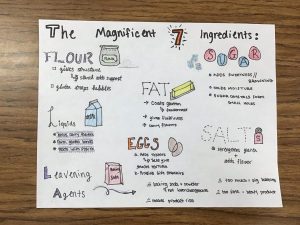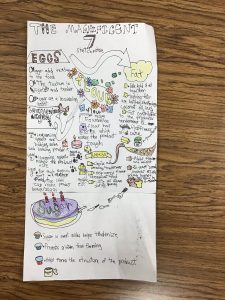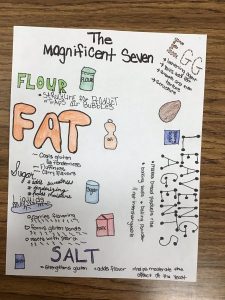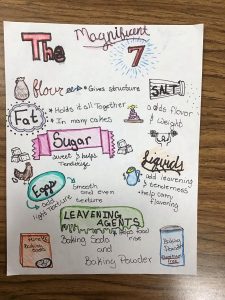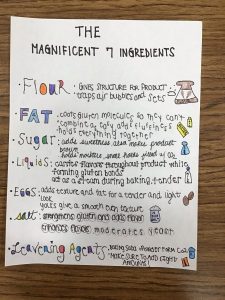After reading Tisha Richmond’s blog & book titled, “Make Learning Magical“, I wanted to give sketchnotes a try. The problem was, finding a 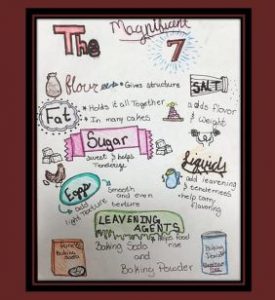 good topic. In addition, I wanted to amp up the excitement to get my students to buy into the concept. Since there are 7 baking ingredients, I decided to call them the “Magnificent 7” because of how well they work together, similar to the characters in the movie of the same name. The first day of sketchnotes was met with mixed reviews….some students grumbled, while others really got into it. Later, some of the students who were a bit skeptical said they actually liked it and found it relaxing! I loved that my students bought into this concept and I have to admit they were fun to grade!
good topic. In addition, I wanted to amp up the excitement to get my students to buy into the concept. Since there are 7 baking ingredients, I decided to call them the “Magnificent 7” because of how well they work together, similar to the characters in the movie of the same name. The first day of sketchnotes was met with mixed reviews….some students grumbled, while others really got into it. Later, some of the students who were a bit skeptical said they actually liked it and found it relaxing! I loved that my students bought into this concept and I have to admit they were fun to grade!
Set
- Introduce the concept of sketchnotes and explain the research behind it as described in Tisha Richmond’s blog post. I showed my students the YouTube video titled Basic Sketchnote Tips so they could see what was involved. Some students also pulled this little picture cheat sheet of the tips up on their iPads for inspiration. Stress that this is a process and that the illustrations don’t have to be perfect, but remind students that they do need to take their time and be neat.
- Pass out the assignment sheet, the blank paper and give students the link to the article Baking Ingredient Science from which to take their notes from.
Materials
- iPads or Laptops
- Projector & Screen
- Blank Paper
- Black Sharpies (thin tips) (affiliate link)
- Colored Pencils (affiliate link)
- Lab Ingredients
Activities
- The following day, after students have completed their notes, I pose a bell ringer question to them in Google Classroom. The bell ringer is Why do you think the “Magnificent 7” are so magnificent in the world of baking? While students are answering this bell ringer, I have the “Magnificent 7″ theme song/instrumental music playing in the background via YouTube to amp up the enthusiasm and fun.
- We then talk about what makes the “Magnificent 7” so magnificent. My students responded…
- Each serves a specific function and therefore, work well together.is
- Their working together produces some amazing end products.
- By changing up the magnificent 7 and measuring accurately, you can make a variety of different baked goods–cookies, quick breads, pancakes, waffles, donuts, biscuits, muffins, some cakes, etc.
- Because I want my students to work with the “Magnificent 7” in a lab, I show them Alton Brown’s Good Eats “Three Chips for Sister Marsha” (available for a couple of bucks at Amazon) and they complete a guide sheet while viewing. The guide sheet is in the Substitution Science–Cookie Science attachment.
- Since I have 3 kitchens, I assign each kitchen a type of cookie: puffy, chewy and thin/crispy to make in a two-day lab. Each recipe uses all of the “Magnificent 7” ingredients. Students cut each cookie in half after cooling, so each student can sample each type of cookie. The recipes in the Substitution Science–Cookie Science attachment yield 8 cookies. If you want larger yields, here are links to the original recipes for each type of cookie; thin, puffy and chewy.
- As students sample each type of cookie, they fill out the evaluation form included in the aforementioned attachment.
- We then discuss the results of their evaluations and which type of cookie won the “class favorite” award.
- From here, I move into my Quick Bread Unit which continues to reinforce the “Magnificent 7” ingredients and their functions.
Similar Lessons
Attachments
- Magnificent 7 Sketchnotes-Basic Ingredients Fnx (PDF)
- Substitute Science-Cookie Science
- Samples of the Magnificent 7 Sketchnotes

